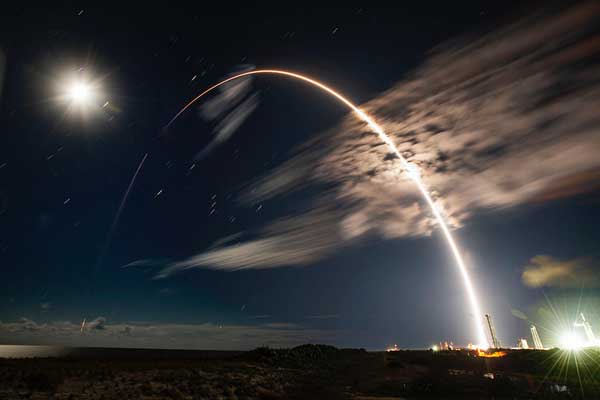
Russia Launched Thrice as Japan’s First Flight of the Year Fell Short (Image Credit: Payload)

Russia launched three times last week as Japan saw its only flight of the year fail with the loss of eight spacecraft. China launched twice, SpaceX flew once, and the world hit 140 launches with 2.5 months left in the year.
The seven launches last week raised the total for October to 15. Up to eight more launches are scheduled through Halloween. That number could change if there are delays or additions in the weeks ahead.
Russia conducted two launches from the Plesetsk Cosmodrome in northern Russia. On Oct. 10, a Soyuz-2.1b rocket with a Fregat upper stage orbited the GLONASS-K 17L navigation satellite. Five days later, the second orbital launch of the Angara 1.2 rocket deposited the EMKA No. 3 spacecraft into orbit for the Ministry of Defence. The payload might be an optical reconnaissance satellite.
Russia’s Proton booster orbited the AngoSat-2 geosynchronous communications satellite for Angola on Oct. 12. It was a rare flight for the venerable booster, which hadn’t launched in 10 months.
Orbital Launches
Oct. 10 – 16 2022
| Date | Launcher – Organization | Payload – Organization | Purpose | Launch Site |
|---|---|---|---|---|
| Oct. 10, 2022 | Soyuz-2.1b/Fregat — RVSN RF~ | GLONASS-K 17L (K1 №5) – VKS# | Navigation | Plesetsk |
| Oct. 12, 2022 | Epsilon – Japan Aerospace Exploration Agency [FAILED] | 8 satellites – multiple | Multiple | Uchinoura |
| Oct. 12, 2022 | Proton – Roscosmos | AngoSat-2 – GGPEN^ | GEO comsat | Baikonur |
| Oct. 13, 2022 | Long March 2C – CASC* | S-SAR 01 (Huanjing-2E) – Ministry of National Emergency | Earth observation | Taiyuan |
| Oct. 14, 2022 | Long March 2D — CASC* | Yaogan 36-02A, 36-02B, 36-02C — CAS+ | Reconnaissance | Xichang |
| Oct. 15, 2022 | Falcon 9 — SpaceX | Hotbird 13F — Eutelsat | GEO comsat | Cape Canaveral |
| Oct. 15, 2022 | Angara 1.2 — Roscosmos | EMKA No. 3 — Ministry of Defence | Possibly optical reconnaissance satellite | Plesetsk |
+ Chinese Academy of Sciences
^ National Space Program Management Office
~ Strategic Rocket Forces of the Russian Federation
# Russian Aerospace Forces
Proton once dominated the market for launching GEO comsats, but competition from SpaceX and the shift toward large constellations of smaller satellites in lower orbits have limited flights of the venerable Soviet-era booster. Proton has launched only four times in the last three years, one of which orbited a new module for the International Space Station (ISS).
Speaking of SpaceX, the company launched the Hotbird 13F GEO comsat for Eutelsat from Florida on Oct. 15. It was 47th Falcon 9 launch of the year for Elon Musk’s company. The company conducted 31 in 2021.
On Oct. 12, Japan’s Epsilon rocket veered off course just prior to the separation of the second and third stages. Controllers triggered the booster’s self-destruct system as a safety measure. It was the first and so far only launch by Japan this year.
The rideshare mission carried eight satellites designed to demonstrate new technologies. Payloads lost in the launch failure included:
- RAISE-3 — Japan Aerospace Exploration Agency (JAXA) — Technology demonstration
- QPS-SAR-3 — iQPS — Earth observation
- QPS-SAR-4 — iQPS — Earth observation
- FSI-SAT — Future Science Institute — Technology demonstration
- KOSEN-2 — Yonago College — Technology demonstration
- MAGNARO — Nagoya University — Technology demonstration
- MITSUBA — Kyushu Institute of Technology — Technology demonstration
- WASEDA-SAT-ZERO — Waseda University — Technology demonstration.
China launched the S-SAR 01 (Huanjing-2E) remote sensing satellite for the Ministry of National Emergency on Oct. 13. The following day, a Long March 2D rocket orbited the Yaogan 36-02A, Yaogan 36-02B and 36-02C reconnaissance satellites.
Global Launch Statistics
A total of 140 launches have been attempted worldwide this year, with 134 successes, five failures and one partial failure. The United States continues to lead the world with 69 launches. China is in second place with 46 launches and Russia a distant third with 16 flights. The rest of the world has combined for nine launches with seven successes and a pair of failures.
Launches by Nation, 2022
Through Oct. 16
| Nation | Successes | Failures | Partial Failures | Total | Percentage of Total |
|---|---|---|---|---|---|
| United States | 66 | 2 | 1 | 69 | 49.3 |
| China | 45 | 1 | 0 | 46 | 32.9 |
| Russia | 16 | 0 | 0 | 16 | 11.4 |
| Europe | 3 | 0 | 0 | 3 | 2.1 |
| India | 2 | 1 | 0 | 3 | 2.1 |
| Iran | 1 | 0 | 0 | 1 | 0.7 |
| South Korea | 1 | 0 | 0 | 1 | 0.7 |
| Japan | 0 | 1 | 0 | 1 | 0.7 |
| Total | 134 | 5 | 1 | 140 | 100 |
The world is now one short of the 135 successful launches completed and six short of the 146 orbital flights attempted in 2021.
Launch Statistics
2019-2022
| Outcome | 2019 | 2020 | 2021 | 2022 (Oct. 16) |
|---|---|---|---|---|
| Success | 97 | 104 | 135 | 134 |
| Failure | 5 | 10 | 10 | 5 |
| Partial Failure | 0 | 0 | 1 | 1 |
| TOTAL | 102 | 114 | 146 | 140 |
The marked increase in launches over the past four calendar years has been driven by SpaceX and Chinese companies. New commercial launch vehicles have also began flights in recent years.








